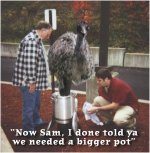Johnny Guest
Moderator in Memoriam
Emu Breeding Pairs - - -
Re: tex_n_cal's questions about value of breeding pairs of emus.
In late 1980s and early-90s, this part of Texas was considered emu heaven. All kindsa people getting into "the business." Newly landed yuppie scum, speculators who'd never had anything to do with ANY like of livestock, even some old-line ranching famblys--Were putting BIG bucks into buying up breeding pairs, stud roosters, certified fertilized, great bloodline eggs, the whole nine meters. The fence builders loved it, some of the vets loved it, the feed supply places couldn't keep Ekanuba Flightless Bird Diet and Purina Emu Chow in stock.
The Sheriff's Office handled a couple of complaints a week for excessive road noise and low-flying aircraft sending the oh-so-sensitive big burds into catatonic seizures. The Highway Patrol Troopers became weary of working motor-vehicle-vs -avian collisions, and ROR (ran off roadway) accidents avoiding same.
Then, slowly, like high speed photography of soap bubbles bursting, the whole "industry" began to come apart. It dawned on owners that, as with the cattle bidness, for every super-valuable stud bull and breeding mama cow, there HAD to be hundreds — probably thousands — of head sold to slaughter houses, just to make ends meet. While there's much good to be said for emu meat, you don't change the beef-pork-chicken diet of generations overnight. Sure, there were lots of emu burgers sold, particularly at outdoor festivals and county fairs. But you don't sell emu drumsticks like you do turkey legs at a renaissance faire or race track. Tout it how you will, people cook emu burger for novelty value, but not for regular consumption when it's thrice the price of good ground beef.
It mostly turned out that the breeders and raisers were doing business with one another, buying, selling and trading with other speculators. As with so many other areas of investment, those who first recognized the downward trend made out best. They sold out of the business early on, and went on to something else. The small-time, get rich quick types who hung on to the bitter end, did not fare well. Rather than keep on feeding birds from which they would never get rich, they sold out at a big loss, gave the birds away, or slaughtered ‘em and filled up their freezers with this good, wholesome meat. And the freezers of their extended family, and their friends, and their cousins-step-neighbors-in-law.
And, finally, those who ate too much emu filet and stew and ragout, got tired of it. There were also those who couldn't face ACTUALLY KILLING AND EATING their near-pets. So, many emu (emus??) were simply turned loose.
You can still get a few bucks for a live emu in this area, but hardly enough to pay for the hassle of maintaining and transporting it. Emu meat is still good, nourishing, grub. But the bloom is gone from the rose, at least around here . . . .

Best,
Johnny
Re: tex_n_cal's questions about value of breeding pairs of emus.
In late 1980s and early-90s, this part of Texas was considered emu heaven. All kindsa people getting into "the business." Newly landed yuppie scum, speculators who'd never had anything to do with ANY like of livestock, even some old-line ranching famblys--Were putting BIG bucks into buying up breeding pairs, stud roosters, certified fertilized, great bloodline eggs, the whole nine meters. The fence builders loved it, some of the vets loved it, the feed supply places couldn't keep Ekanuba Flightless Bird Diet and Purina Emu Chow in stock.
The Sheriff's Office handled a couple of complaints a week for excessive road noise and low-flying aircraft sending the oh-so-sensitive big burds into catatonic seizures. The Highway Patrol Troopers became weary of working motor-vehicle-vs -avian collisions, and ROR (ran off roadway) accidents avoiding same.
Then, slowly, like high speed photography of soap bubbles bursting, the whole "industry" began to come apart. It dawned on owners that, as with the cattle bidness, for every super-valuable stud bull and breeding mama cow, there HAD to be hundreds — probably thousands — of head sold to slaughter houses, just to make ends meet. While there's much good to be said for emu meat, you don't change the beef-pork-chicken diet of generations overnight. Sure, there were lots of emu burgers sold, particularly at outdoor festivals and county fairs. But you don't sell emu drumsticks like you do turkey legs at a renaissance faire or race track. Tout it how you will, people cook emu burger for novelty value, but not for regular consumption when it's thrice the price of good ground beef.
It mostly turned out that the breeders and raisers were doing business with one another, buying, selling and trading with other speculators. As with so many other areas of investment, those who first recognized the downward trend made out best. They sold out of the business early on, and went on to something else. The small-time, get rich quick types who hung on to the bitter end, did not fare well. Rather than keep on feeding birds from which they would never get rich, they sold out at a big loss, gave the birds away, or slaughtered ‘em and filled up their freezers with this good, wholesome meat. And the freezers of their extended family, and their friends, and their cousins-step-neighbors-in-law.
And, finally, those who ate too much emu filet and stew and ragout, got tired of it. There were also those who couldn't face ACTUALLY KILLING AND EATING their near-pets. So, many emu (emus??) were simply turned loose.
You can still get a few bucks for a live emu in this area, but hardly enough to pay for the hassle of maintaining and transporting it. Emu meat is still good, nourishing, grub. But the bloom is gone from the rose, at least around here . . . .
Best,
Johnny

